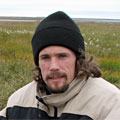Summer Days Are Over
LARAMIE, WYOMING– Shortly after my last posting, I received a phone call on a Tuesday evening from my collaborators who are based in Anchorage, Alaska. One of the bears which we sampled last May had been active near the town of Kaktovik, on the Arctic coast (the town is described in this dispatch). Location data from the radio collar, relayed by satellite, indicated the bear had been traveling through town, and residents had called to report a bear wearing a collar in the area. Unfortunately, the bear appeared to be in poor condition and was very skinny. This raised the concern that the bear was in ill health, and its presence in town created the possibility of a bear-human interaction. Thus, it was decided to recapture the bear and assess its condition.
About twelve hours after receiving the phone call, I had dropped all other plans and I was on a plane to Alaska. Within several days we mobilized two helicopters and pilots up to the coast, rounded up all the necessary gear, and performed the capture near Kaktovik. After examining the bear closely, fortunately, she was not in ill health and she was not experiencing any complications from previous sampling. Although it is difficult to know, it seems she simply had a tough spring, perhaps due to poor hunting success or other factors.
I did not return to Laramie until the following Monday, after missing the first week of classes on campus. I was very happy that the safety of Kaktovik residents and of the bear had not been jeopardized, but it was certainly a reminder of the important complexities involved with studying polar bears on the north slope.
Today, as I write this, I have about two hours to finish packing before departing for Barrow, Alaska. My advisor Dr. Hank Harlow and I will arrive in Barrow tomorrow night at about 7:15 pm, where it will be around 25 to 30 degrees (Fahrenheit) and hopefully with a little snow on the ground. My co-advisor, Dr. Merav Ben-David, will arrive the following morning, and eventually a total of about 20 personnel will show up. The group includes our collaborators from USGS and USFWS, a photographer, a film crew, a high school teacher, and several other Arctic-based research groups. The other projects are varied, focusing on primary production in sea water, algal growth on the underside of sea ice, and sea birds and mammals. All 20 personnel will be ferried onto the USCG icebreaker Polar Sea via helicopter, hopefully on Saturday. Once onboard, we will cruise towards the edge of the sea ice, about 400 miles north of Barrow.
Every year, the sea ice reaches it minimum extent around mid-September, and this year’s minimum appears to have occurred on September 12th. The National Snow and Ice Data Center has posted a map and description here; from this point on, the ice will be expanding as temperatures drop below freezing across the Arctic. Thus, as we cruise north, the ice will be slowly expanding south towards us.
The website Cryosphere Today has a color-coded map depicting current sea ice conditions, shown below. Remarkably, the three smallest minimum extents during the era of satellite measurements – beginning 1979 – are 2009, 2008, and 2007. In other words, the Arctic has had less ice in the last three summers than in any other summer since 1979.
I am very excited about working from the icebreaker. It is an incredibly rare opportunity to not only get a sense of the far northern sea ice environment, but also to collect valuable data from a important species that is so strongly associated with it.

 No comments
No comments 







